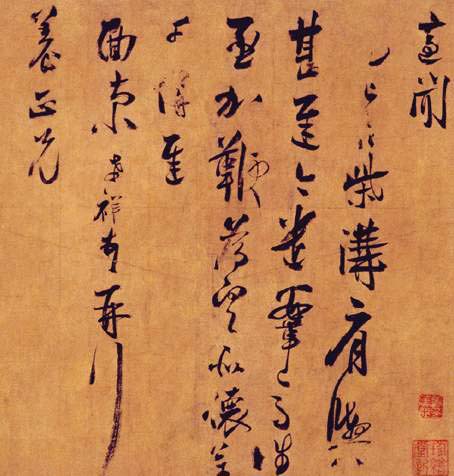Zhang Xiaoxiang (1132-1169) was a famous poet and calligrapher in the Southern Song Dynasty. His courtesy name was Anguo and his nickname was Yuhu Jushi. He was a native of Wujiang, Liyang (now Hexian County, Anhui Province). In the 24th year of Shaoxing, Emperor Gaozong of the Song Dynasty (1154), he ranked first in the imperial examination. The official and secretary provinces are straight characters, and the daily life is for people. He was compiled by Jiyingdian, pacified envoys of Jingnan and Hubei, and served as a direct bachelor of Xianmo Pavilion. As an official, he should be "accurate in his duties" and "remarkable in his administration". Emperor Xiaozong of the Song Dynasty died in the fifth year of his reign (1169) at the age of thirty-eight.
Zhang Xiaoxiang is a very talented and ambitious person. He is the author of "Yuhu Collection" and "Yuhu Ci". His style of poetry is bold and passionate, he is worried and angry about national affairs, insists on resisting the Jin Dynasty, and strongly demands to restore the unity of the country. The long tune "Six States Song Tou" is particularly touching. "History of the Song Dynasty" said that his articles were outstanding, especially his craftsmanship and calligraphy. When Emperor Gaozong read the letters and memorials written by his relatives, he said, "Zhang Xiaoxiang is both beautiful in poetry and writing, and will definitely become famous in the world." Among the calligraphers of the Shaoxing period, only Wu Shuo and Zhang Xiaoxiang were praised by Emperor Gaozong and are relatively well-known. Zhang Xiaoxiang is famous for his "three unique skills" in strategy, poetry and writing. "Jianning Mansion Chronicles" records: "Gaozong of the Song Dynasty was very fond of calligraphy and calligraphy. Zhang Xiaoxiang was in the court, and he still had no idea. He answered questions with wet hair, and he immediately answered ten thousand words. After reading it, the calligraphy and painting are powerful, outstanding, and Yan Lugong is also dear. Promote first choice.”

"Chaigou Tie"
Chai Gou Tie, paper, running script, length 33.5 cm, width 38.9 cm, collected by Shanghai Museum. This post has seven lines and thirty-eight characters, of which the first three characters of the second line are mostly missing. In a letter written by Zhang Xiaoxiang to his friend Yangzheng, Zhang Xiaoxiang told Yangzheng: Because I heard that the visit by sedan was very slow, I sent someone to borrow a pommel horse to greet him and wanted to meet his friend as soon as possible. The place referred to as Chaigou is yet to be examined. This post has the majestic and majestic spirit of Yan Zhenqing, which is vigorous and rigorous, powerful and smooth, steady but not frivolous, and contains strong bones. His strokes use both square and round strokes, mainly in the center. His lines are dignified and elegant, and his strokes are thick and finely divided. Generally, the horizontal strokes are light and the vertical strokes are heavy. He is famous for his wonderful brushwork in which Yan characters are folded and turned, and the square is turned into a circle. The lines are broad and hearty, and are integrated in one go, like the stars in the sky, twinkling naturally, giving the viewer a sense of relaxation and relaxation. The layout of the composition is empty and concise, and the thick black lines of characters are like flying geese in the blue sky and white clouds. The distance between the paragraphs on the picture creates a layered and eye-catching flowing rhythm, which also gives people a clear and simple feeling. Light beauty. It is the representative work of Zhang Xiaoxiang's ink writing handed down from generation to generation. It was once collected by Zhang Duxing of the Qing Dynasty, and the post has a seal.








